Friday, December 29, 2006
Chocolate Chicanery
Thursday, December 28, 2006
Ear Stapling
 Once again I find myself muscling in on Orac’s territory. I passed through Foley, Alabama, a few times over the holidays, and on one trip I noticed a shop advertising “ear stapling” for smoking cessation and weight loss.
Once again I find myself muscling in on Orac’s territory. I passed through Foley, Alabama, a few times over the holidays, and on one trip I noticed a shop advertising “ear stapling” for smoking cessation and weight loss.According to the Ear Stapling Association, the procedure is derived from ancient Chinese acupuncture.
An interesting claim from the site…
“Ear stapling has been around for decades. It has been scientifically proven that different points in the ear demonstrate high electricity that is related to different points of the body. When the body is stressed, unbalanced, or even diseased, an increase of energy is put out. In theory, energy flow is enhanced to this area of the body. This is how the staple works, by tapping into the energy flow called Chi.”
Naturally the claim that “It has been scientifically proven that different points in the ear demonstrate high electricity that is related to different points of the body” doesn’t include a reference. Don’t they know that when you make a claim of scientific support, you’re supposed to identify the source? Ads for pharmaceuticals are covered with fine print referring to the studies conducted to prove that their products are both safe and effective. Unfortunately, purveyors of woo are held to a much lower standard.
Here’s another good give-away quote…
“It is believed that one ear is more effective than the other.”
When people start telling you about something that “is believed” without specifying who believes it and why they believe it, you know you’re dealing with a claim that has no legitimate supporting evidence.
“Ear Stapling is perfectly safe and there are no side effects regarding any medical condition.”
The safety claim is quite valid; useless treatments are quite often harmless treatments. Ear stapling is certainly no more dangerous than a cosmetic ear piercing, and millions of people have gotten those without harm. It’s also a no-brainer that ear stapling should have no medical side effects, since there’s no evidence that it has any medical effects at all, good or bad.
“Within the first seven days 90% of our participants report an average weight loss of 4-5 pounds. Our participants that wish to stop smoking have reported to us that within the first 24 hours their craving for cigarettes is cut almost in half.”
I daresay the results are probably the same for any other placebo; people tend to be motivated immediately after they’ve undergone a painful and costly procedure to help them with a specific behavioral problem. Of course, Dr. Martinez doesn’t provide any long-term success statistics for his patients. Information like that would probably be damning, if it were collected and examined properly.
Ear stapling is a good way to lose some money and take a small risk of infection to accomplish nothing of consequence.
Friday, December 22, 2006
Skepticality and Silliness
Also, Reiblue introduced me to the following bit if internet silliness. The result I got amuses me so much that I feel compelled to share.
 | My Peculiar Aristocratic Title is: His Highness Runolfr the Apocalyptic of Lesser Wobbleton Get your Peculiar Aristocratic Title |
Wednesday, December 20, 2006
Creationism in Video Game Form
If you're not familiar with the premise, the game begins after the Biblical Rapture has occurred, and millions of people have abruptly disappeared. Those "Left Behind" have to choose sides in the final struggle on Earth between God and the Devil. It's fundamentalism all the way as you wage war against the forces of the other side (I understand that in at least some modes, you can play "the Devil's advocate") to gain the most converts and eliminate the most enemies. If you guessed that this game was a fundamentalist proselytization tool aimed at the the young video-gaming crowd, you'd be right. You can read a review at Ars Technica.
Of particular interest is a capture of an "informational" screen in the game...

I suppose it shouldn't surprise me that a fundie video game peddles the same anti-science cliches that fill all Creationist websites and literature, but it's still annoying.
In their "Evolution for Fundies" definition, they use the oft-repeated claim that genetic variation and adaptation within a species (what they call "micro-evolution") is no reason to think that new species can diverge from such populations (what they call "macro-evolution"). Apparently they think that some magical barrier exists that keeps the adaptations from continuing and populations from becoming so dissimilar that they can no longer be considered the same species. They ask "Is it scientifically credible to use the genetic changes within a species to argue that these same mechanisms can progressively transform one species into a more successful and adapted new species?"
The question is phrased poorly, but the nutshell answer is "Yes." It is scientifically credible to argue that in a varied population, the individuals that are best adapted to the environment will have the most reproductive success, and their genes will become more common in future generations. It is scientifically credible to argue that the same mechanisms that create variation within a species can also cause populations to become non-interbreeding and progressively less similar (in both form and genetic makeup) as they adapt to different environments and ways of life. It is scientifically credible to argue that the same mechanism that drives "micro-evolution" would naturally lead to "macro-evolution". The creationists may think it's a rhetorical question, and maybe it is, but they certainly have the answer backwards.
Naturally they escalate from the question of biological evolution to universal cosmology as if the topics were the same. Why should we expect anything new from creationists? They even throw in an out-of-context quote to seal the deal.
Edit: Researching it further, the quote from Sir Arthur Keith -- "Evolution is unproved and unprovable. We believe it because the only alternative is special creation, and that is unthinkable." -- appears to be a creationist fabrication. There is no credible evidence that he said any such thing.
Saturday, December 16, 2006
The Abbatoir
 If you're a vegetarian, or you otherwise think deer are so cute and cuddly that nothing bad should ever happen to them, click away to another site right now. This is going to be a fairly gruesome combination of pictures and descriptions.
If you're a vegetarian, or you otherwise think deer are so cute and cuddly that nothing bad should ever happen to them, click away to another site right now. This is going to be a fairly gruesome combination of pictures and descriptions.I'm not a vegetarian. I also think that people who are going to eat meat should be willing to get their hands dirty. Too many people think meat comes from the grocery store. My grandfather took me hunting a couple of times when I was younger. I didn't kill anything on those trips, but I did pull the trigger with intent to kill a couple of times, so I'm comfortable with my place at the top of the food chain. I also helped clean and cut up the kills that other hunters made; I got over my squeamishness pretty quickly. I prefer to let others do the dirty work these days, but I will get in there when the need arises. I must admit that my good lady wife did most of the work on this occasion, but I did lend a hand as needed.
So, my father-in-law shot a deer for us a few weeks ago. It spent some time in the freezer, then a few days hanging in the cool wintery air, and today it came into the house to be dismembered. The loft design of our house, with exposed rafters, makes this process much easier, but lugging around over a hundred pounds of dead weight (yeah, pun intended) is still no easy task. Still, we managed to get the deer from its hanging place in the barn to a new hanging place in the house without too much trouble.
 The hanging, by the way, reported takes away some of the "gamey" taste that turns some people off venison and tenderizes the meat by stretching out the tissue. The "aging" process needs to occur in temperatures of around 40 degrees Fahrenheit and low humidity. It will take three to ten days, depending on temperatures. This is a bit creepy, but if you find a bit of mold growing inside the rib cage, that's actually a good sign. Where you have mold, you don't have nasty bacteria. Basically, if it's gotten slimy and stinky, it may no longer be safe. I suppose you could wash any visible mold from parts you plan to eat, but we're actually making jerky treats for our dogs from those.
The hanging, by the way, reported takes away some of the "gamey" taste that turns some people off venison and tenderizes the meat by stretching out the tissue. The "aging" process needs to occur in temperatures of around 40 degrees Fahrenheit and low humidity. It will take three to ten days, depending on temperatures. This is a bit creepy, but if you find a bit of mold growing inside the rib cage, that's actually a good sign. Where you have mold, you don't have nasty bacteria. Basically, if it's gotten slimy and stinky, it may no longer be safe. I suppose you could wash any visible mold from parts you plan to eat, but we're actually making jerky treats for our dogs from those.I didn't think to immortalize the earliest stages of the process in pictures, so you don't have to witness the beheading and skinning of the beast. Basically, the decapitation involves cutting a ring around the neck all the way to the spine, then popping the vertebrae apart. Skinning requires cutting the skin away starting at the legs (from which the deer is suspended) and then pulling with all your weight while using a skinning knife to help the skin separate from the underlying muscle.
With the hide off, the true dismemberment began. This basically involves separating large tracts of muscle from the bone, starting with my lady's favorite cut: the backstrap. Once the assorted cuts are removed, they get washed (my job!) and refrigerated until they can be further cut down into individual servings.
The hide went into a plastic bag and then into the freezer, hopefully to eventually go into someone's leatherworking project. Assorted bones and other unpalatable bits of the animal went to a compost pile, except for a few bones that went to some extremely happy dogs.
If you're one of my local readers, and you want a deer hide for tanning, let me know.
Tuesday, December 12, 2006
Think Before You Bleed
NURSE: Did you eat breakfast this morning?
DONOR: No.
NURSE: What did you have for supper last night?
DONOR: (head shake with mumbled negative)
NURSE: What were you thinking donating blood when you didn’t eat dinner last night or breakfast this morning?
Saturday, December 09, 2006
Am I Obsessed?
Which lead to my obsessive-compulsive problem. Listening to all the jazz music and watching the dancers, I couldn't help but notice that all the songs were in 4/4 time, which means it would be easy to match them to English Country or Renaissance Italian dances. Now I need to get myself a jazz album.
How weird is that?
Wednesday, December 06, 2006
How Do You Know So Much About Swallows?
Monday, December 04, 2006
Pewter Casting with Two-Part Molds
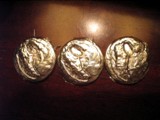 After many delays – not all avoidable – I have revisited my pewter casting work. I’ll start off by thanking my good lady wife Jolief, who assisted with every step of the process in this second effort at pewter casting.
After many delays – not all avoidable – I have revisited my pewter casting work. I’ll start off by thanking my good lady wife Jolief, who assisted with every step of the process in this second effort at pewter casting.I’ll also say upfront that this particular effort serves as an excellent proof of concept for casting items in two-part molds, but my skills as a sculptor have a long way to go.
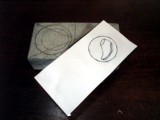 Our first step in this new casting project was to prepare the mold. In our case, we carved our “negative” into just one block of soapstone. I’m not ready to attempt two-sided objects just yet, so the back of the medallion we produced is flat. This isn’t a particularly complicated design. It’s really just an image of a shoe, intended for use as an “Order of the Argent Slipper” medallion.
Our first step in this new casting project was to prepare the mold. In our case, we carved our “negative” into just one block of soapstone. I’m not ready to attempt two-sided objects just yet, so the back of the medallion we produced is flat. This isn’t a particularly complicated design. It’s really just an image of a shoe, intended for use as an “Order of the Argent Slipper” medallion.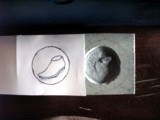 We completed this mold in one day by taking turns at the carving and using modern technological assistance. This isn’t intended to be an A&S competition piece, so I’m not concerned about taking such shortcuts.
We completed this mold in one day by taking turns at the carving and using modern technological assistance. This isn’t intended to be an A&S competition piece, so I’m not concerned about taking such shortcuts.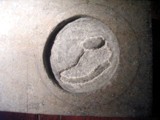 With the design complete, the next step was to carve a path to let metal into the mold and additional paths to let air escape. After doing that, all I needed to do was clamp a flat, blank piece of soapstone onto the carved mold, heat some pewter, and pour it down the funnel.
With the design complete, the next step was to carve a path to let metal into the mold and additional paths to let air escape. After doing that, all I needed to do was clamp a flat, blank piece of soapstone onto the carved mold, heat some pewter, and pour it down the funnel.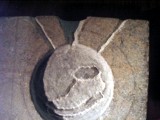 I was surprised at how easily this part of the process worked after the difficulties I had with my attempt at an open-faced mold. The mold filled completely (and often overflowed) on every single try, producing consistent finished pieces that showcased every imperfection in my carving technique with exquisite detail.
I was surprised at how easily this part of the process worked after the difficulties I had with my attempt at an open-faced mold. The mold filled completely (and often overflowed) on every single try, producing consistent finished pieces that showcased every imperfection in my carving technique with exquisite detail.Realizing that the initial effort to make the sole of the shoe separate from the rest of it resulted in an image that looked more like an ice skate, we attempted some correction work on the mold. It’s rather convenient to be able to do touch-up work on the mold this way, then make a new run of castings. Alas, the second round of medallions weren’t that much of an improvement.

Nonetheless, we have now established that two-part pewter castings of this type work very well with the pewter alloy that I have available. For my next effort, I will probably attempt this same work again from scratch, trying to remember that the finished product will be a mirror image of the original (so the shoe points the way I intended) and hand-carving the design to hopefully reduce the number of tool marks in the finished pieces.
EDIT: See my even-more-embarrassing first attempt.
Tuesday, November 28, 2006
I'm participating in an Experiment
I'll also link to an amusing story about Reiki healing from the Pretentious Narcissistic Misanthrope.
Tuesday, November 21, 2006
Faculty-of-Medicine Wants My Help
Hi,NOTE: I recently received a message from the staff of the site that "Jane Fields" named in her email to me. The site she named disavows any connection with facultyofmedicine.net and politely asked me to remove their name from this article due to the bad publicity (apparently this page floated to the top in Google searches for their name). Since it appears that "Jane" was just name-dropping to give herself credibility, I have complied with the request.
I think your site and [sitename] can be a good match for linking.
[sitename] does not have a link page, but we offer three way linking (better than the usual linking) from facultyofmedicine.net.
If this is of any interest to you please respond.
Thanks,
Jane Fields,
POB 200067, Pittsburgh, PA
Hey, if she wants to freely share her contact information with strangers over the internet, who am I to stop her? It’s not like there’s any reason to assume this is a legitimate name, anyway.
A quick look at the “facultyofmedicine” site reveals what looks like an online bookstore. Someone has basically put together a list of vaguely medical titles with links to Amazon to sell them.
Browse through an extensive selection of Medicine books on subjects such as Anatomy, Cardiology, Neurology and more.This doesn’t seem like such a bad site. It's a simple money maker for someone who wants to make money off medical students without actually having to maintain an inventory, but there's nothing wrong with that. Of course, scrolling down the page, what should I find as the sixth book on their list but...
Natural Cures "They" Don't Want You To Know About Written by Kevin TrudeauFollowed by a couple more beauties like Suzanne Somers' Slim & Sexy Forever: The Hormone Solution for Permanent Weight Loss & Optimal Living and Everything You Need to Know to Feel Go(o)d.
All these on a page titled “MEDICINE STUDENT BOOKS”. If this kind of material is included in medical school curricula, I feel I must quake in fear should I ever become ill.
They’re not all like that of course. There are titles like the Handbook of Evidence-based Radiation Oncology, too, but seeing the woo mixed freely with the substantiated is rather disconcerting.
One title is Outsmart Your Cancer: Alternative Non-Toxic Treatments That Work. The Amazon description says...
Learn the unique characteristics common to all cancers. Read testimonials from many who have completely recovered using alternative approaches. Learn why non-toxic methods are so effective and how to obtain them.Testimonials instead of evidence; this does not bode well. I’m sure Orac can do a much better job of examining such claims than I can, but I would far sooner follow the instructions of an experienced medical doctor than the advice of someone with no medical training of any kind (and no, the author -- Tanya Harter Pierce – is not a doctor).
I guess the problem that I have with this site is that it randomly mixes unsubstantiated claims with legitimate medical literature, lending an air of credibility to the unsupported CAM books.
So, sorry Jane, but I won’t be giving you a link; I don’t want to do anything to improve your Google score. Even my readers will have to hand-key the URL into their browsers to see what I’m talking about (sorry for the inconvenience, guys).
Monday, November 13, 2006
My Accent Results
| What American accent do you have? Your Result: The Midland "You have a Midland accent" is just another way of saying "you don't have an accent." You probably are from the Midland (Pennsylvania, southern Ohio, southern Indiana, southern Illinois, and Missouri) but then for all we know you could be from Florida or Charleston or one of those big southern cities like Atlanta or Dallas. You have a good voice for TV and radio. | |
| The South | |
| Philadelphia | |
| The Inland North | |
| The Northeast | |
| The West | |
| Boston | |
| North Central | |
| What American accent do you have? Take More Quizzes | |
So, based on that, would it surprise you to know that I was born and raised in East Tennesse, and that both of my parents are from south Alabama? I also went to college in South Carolina, if you think that's relevant. I have no explanation, but it was interesting to have this test affirm what other people have told me.
Sunday, November 12, 2006
Bringing Forth Wine
 This has been a busy day for us, but all likeable activities. We racked my Lady's "Grog" (a molasses beer), bottled Apricot Wine and Sassafras Mead, and started a new batch of Concord Wine.
This has been a busy day for us, but all likeable activities. We racked my Lady's "Grog" (a molasses beer), bottled Apricot Wine and Sassafras Mead, and started a new batch of Concord Wine.We had originally planned to bottle the Grog, but I miscalculated the amount of priming sugar. It's a one-gallon batch, but without thinking I quoted the sugar addition for a five-gallon batch. Not wanting to create grenades, we decided to rack it into another carboy and let it ferment out the excess sugar.
Bottling the Apricot Wine was the second project of the day. This wine was made from common white grape juice (Niagara is the variety used, I'm told) mixed with "apricot nectar". I don't actually know what makes "nectar" different from "juice", but it certainly seems to carry a lot of flavor. This is actually a pretty simple sweet wine, so fancy bottling wasn't required. We used miniature soda bottles with crown caps.

 After bottling the wine, we moved on to bottling the Sassafras Mead. As with our last batch, this mead has exquisite color and clarity. Unlike the last batch, this one is almost drinkable already. It still has a bit of a jet fuel aftertaste, though, so it will get to lay in a wine rack for a year or so before we serve it to anyone. If past experience is any guide, this will be an excellent mead in a few years.
After bottling the wine, we moved on to bottling the Sassafras Mead. As with our last batch, this mead has exquisite color and clarity. Unlike the last batch, this one is almost drinkable already. It still has a bit of a jet fuel aftertaste, though, so it will get to lay in a wine rack for a year or so before we serve it to anyone. If past experience is any guide, this will be an excellent mead in a few years. Our final project of the day was to start a brand new batch of Concord Wine. We've made this wine before as a sparkling wine that carbonates in the bottle (and won a blue ribbon in the sparkling division at the Tennessee Viticultural & Oenological Society wine contest, I might add). We'll be using slightly easier methods this time; this will be a sweet, still wine that we'll "bottle" in a cornelius keg and then pressurize. Our objective is to have it ready in time for Gulf Wars XVI.
Our final project of the day was to start a brand new batch of Concord Wine. We've made this wine before as a sparkling wine that carbonates in the bottle (and won a blue ribbon in the sparkling division at the Tennessee Viticultural & Oenological Society wine contest, I might add). We'll be using slightly easier methods this time; this will be a sweet, still wine that we'll "bottle" in a cornelius keg and then pressurize. Our objective is to have it ready in time for Gulf Wars XVI.This batch of wine started with common Concord grape juice that you can find at any grocery. Having more presence of mind than usual, I remembered to take hydrometer readings of the juice before starting fermentation. Our juice had a specific gravity of 1.065, which is sweet enough to carry the wine to about 8% alcohol after fermentation. That's not enough; the wine wouldn't be strong enough to keep vinegar bacteria from establishing themselves. We therefore needed to add some sugar.
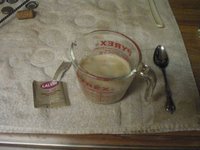 This operation involved dumping five pounds of sugar into an empty grapejuice bottle, pouring about half a bottle of juice in after, and then shaking vigorously to mix the sugar into the juice. We then poured the mixture into the carboy. This little operation brought the specific gravity up to 1.100, which should make a wine with about 13% alcohol.
This operation involved dumping five pounds of sugar into an empty grapejuice bottle, pouring about half a bottle of juice in after, and then shaking vigorously to mix the sugar into the juice. We then poured the mixture into the carboy. This little operation brought the specific gravity up to 1.100, which should make a wine with about 13% alcohol. After proofing some Lalvin 71B-1122 wine yeast (saccharomyces cerevisiae), we added it to the carboy, and we saw the first signs of fermentation within the hour. The wine can sit quietly in a corner for a few weeks while it goes through its primary fermentation. After that, it should slow down enough for its first racking.
After proofing some Lalvin 71B-1122 wine yeast (saccharomyces cerevisiae), we added it to the carboy, and we saw the first signs of fermentation within the hour. The wine can sit quietly in a corner for a few weeks while it goes through its primary fermentation. After that, it should slow down enough for its first racking.I shall try to remember to document the entire procedure here at the Saga.
Thursday, November 09, 2006
Skeptics' Circle 47
Wednesday, November 08, 2006
Slashing Soapstone
 In my very slow quest to cast some nice pewter medallions, I acquired a large slab of soapstone for making two-part molds. I'm switching to two part molds instead of open molds because the pewter I'm using isn't particularly well suited to open-faced casting, and I'm not keen to alloy it with lead so it will be more suited to that method. No, I'd rather avoid the toxic heavy metals as much as I may.
In my very slow quest to cast some nice pewter medallions, I acquired a large slab of soapstone for making two-part molds. I'm switching to two part molds instead of open molds because the pewter I'm using isn't particularly well suited to open-faced casting, and I'm not keen to alloy it with lead so it will be more suited to that method. No, I'd rather avoid the toxic heavy metals as much as I may.Consequently, I needed to cut my slab of soapstone down to manageable-sized blocks. Soapstone is a pretty soft stone that's easy to carve and cut, of course, so I figured that a bit of work with a hacksaw would make neat pieces without too much difficulty. Needless to say that was a notion born from a deranged thread of optimism floating idly through my addled mind. A hacksaw will certainly cut through soapstone, but it is abysmally slow going, as roughly an hour (non-continuous) of hacking didn't even get half way through the block.
 Unrelated events happened to work in my favor, though. As I mentioned long ago, the catastrophic failure of our water heater forced us to rip out our carpeting, and we spent much of the last few months laying a tile floor in its place. My brother- and sister-in-law loaned us a tile-cutting table-saw for the duration of the project, and after the floor was finished, I took the opportunity to turn that stone cutting blade against my slab of soapstone. In just a few seconds it cut through more soapstone than I'd been able to go through in nearly an hour of hacking.
Unrelated events happened to work in my favor, though. As I mentioned long ago, the catastrophic failure of our water heater forced us to rip out our carpeting, and we spent much of the last few months laying a tile floor in its place. My brother- and sister-in-law loaned us a tile-cutting table-saw for the duration of the project, and after the floor was finished, I took the opportunity to turn that stone cutting blade against my slab of soapstone. In just a few seconds it cut through more soapstone than I'd been able to go through in nearly an hour of hacking.So, soapstone blocks secured, I must now find time to carve some molds.
Wednesday, November 01, 2006
Nautical Nonsense for Halloween
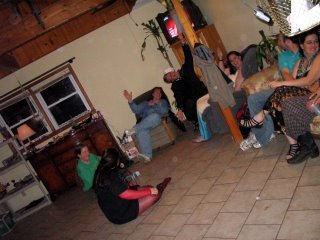 Our second annual Halloween Party was a success this year. At least I think so, and I've gotten good feedback so far.
Our second annual Halloween Party was a success this year. At least I think so, and I've gotten good feedback so far.As usual we had a few games planned, some for kids and some for adults. The main kid-friendly game was the treasure hunt. Since it was a nautically themed party, this was a supposed pirate treasure hidden somewhere on the property. We came up with a few clues to lead participating guests on a merry chase through the fields (in the dark, with only two flashlights). We tried not to be too stingy with the treasure, either: we put actual cash in there along with an assortment of costume jewelry. Since the treasure chest and the key were hidden separately (ah, gotta love movie inspiration), the finders of each ended up splitting the treasure.
Other entertainments included a surprising amount of renaissance dancing (not expected, but definitely welcome), rubber duck races, and a game of fishing for bottles. The bottle fishing was the brutal adult game, since we were talking mini-bottles, and you had to empty the one you caught before you could cast for another. I had to recover for about an hour after that one.
We also had a costume contest with a lot of interesting costumes. A few pirates, of course; the goddess Thetis; the 13th Warrior (who changed costumes to a pirate later); the figurehead of a ship; an island; an aquarium; and a sailor. The island got the prize.
 Good food and drink always help make a party, so we included contests for them as well. My Captain Jack won best drink, since no one else entered anything, but we had several entries in the food contest.
Good food and drink always help make a party, so we included contests for them as well. My Captain Jack won best drink, since no one else entered anything, but we had several entries in the food contest.We're looking forward to an "Animated Characters" themed party for next year.
Wednesday, October 25, 2006
Movie Review: Beowulf & Grendel
A better title might have been the “The Vengeance of Poor Misunderstood Grendel Upon the Redneck Danes”. Seriously, the Danes and Geats act like a bunch of rednecks constantly dropping the F-word in Scottish accents. At least the rednecks are smart enough to wear their helmets when they go into a fight.
Grendel is vaguely like an adolescent taking revenge for a legitimate wrong. He lacks the supernatural invulnerability that helped define Grendel in the poem. He's just big, strong, and cunning in a neanderthalish kind of way. He's obviously meant to be a sympathetic character, and quite frankly kicks the butts of Beowulf and everyone else he fights. He pwnez Beowulf and company so bad that he actually has to cut his own arm off so it can get nailed to the wall.
And then there’s the witch Selma, played by Sarah Polley, who helps the story by dropping hints about her friend Grendel’s motivations in an undisguised American accent.
Add in a disposable subplot involving a Christian missionary and a gratuitous visit from Grendel's mother, and you've got something resembling a story that doesn't very much resemble the classic Beowulf.
I’d give this two out of five stars, I guess. Don’t rush to the video store.
Tuesday, October 24, 2006
Random Musings
Speaking of weekends, our annual Halloween party is coming up. I will try to remember to take more pictures this year. Owing to the gratuitous emptiness of the house (due to the floor replacement), we should have plenty of room to bring the festivities indoors for the most part.
Beowulf & Grendel has finally come out on DVD in this country. I’ve been waiting for this release for a while; I really, really hope it doesn’t suck. We may watch it tonight, so I may write a review in the next couple of days.
We’ve also managed to become addicted to Heroes over the last few weeks. Don’t let my skeptical writings fool you; I love this kind of stuff.
Tuesday, October 17, 2006
More Hollywood Antiscience
Time Stopping
This is the supernatural ability of the character Hiro in the NBC series Heroes, as well as a plot point in Star Trek episodes like "Wink of an Eye" from the original series and "Timescape" from The Next Generation.
The plot gimmick in these shows is that time somehow stops or gets slowed tremendously for some characters while continuing normally for others. This means that you have some characters walking around and interacting normally with the environment while the rest are "frozen" by comparison.
Unfortunately, Hollywood writers never consider the consequences of someone experiencing time at a rate hundreds or thousands of times greater than others. As Mike Wong has pointed out on his website in relation to Star Trek, all kinds of things are time dependent that science fiction TV writers don't think about.
For example, the light by which we see is actually time dependent. A 100-watt lightbulb, for instance, is defined by the fact that it converts 100 joules of energy from electrical current into heat and light every second. If a hero alters time so that he's moving 1000 times faster than everyone else, then all the 100-watt bulbs he might be using to see become -- from his point of view -- 0.1-watt lightbulbs, and he's suddenly wandering about in the dark.
Interacting with the environment doesn't stop with sight, either. If you're going 1000 times faster than everyone else, you experience 1000 times as much air resistance as everyone else. From your perspective, the air might feel as thick as water (or worse). Even if your time-bending ability allowed you to move through the air normally, the friction created by your passing would create a super-heated shockwave wherever you went that would blast everyone you walked by (and you, too, when you allowed yourself to return to "normal" speed). If you exert five pounds of force to move an object, that object will actually experience five thousand pounds of force in normal time (which would be sufficient to damage many things you might want to move).
And finally, if you literally "stop time" for everything else, you can't do anything. You can't see, because no light is reaching your eyes. You can't move, because the immobile air is an impenetrable barrier. Actually stopping time would just be an exercise in sensory deprivation (until you suffocate from lack of oxygen, that is).
Sudden Evolution
Offenders in this category include the Star Trek: The Next Generation episode "Transfigurations", the Babylon 5 episode "Mind War", and the B5 TV movie River of Souls. These shows all describe an "evolutionary" change in which living beings of some alien race of the week transform in a bright flash from ordinary flesh-and-blood humanoids into "pure energy" beings who fly away into space (or do other things that only pure-energy beings could do).
To put it bluntly, such a transformation is not "evolutionary". In fact, it's the total opposite of evolution. If the general public got their understanding of the Theory of Evolution from shows like this, it's no wonder that they don't take the theory seriously. Evolution is about tiny variations that accumulate over the course of many generations, not dramatic changes in living examples of a species.
Moral of the Story
If you go to Hollywood for scientific understanding, you become the blind following the blind.
Sunday, October 15, 2006
Rapier Drill: Blade Control
Saturday, October 14, 2006
Rapier Drill: Three Step Drill
As noted, the attacker makes a middle thrust, a low thrust, and a high thrust, advancing a step with each attack. The defender uses Capo Ferro parries four, two, and five (by our numbering system) to deflect the attacks while stepping back each time. The fencers reverse roles after each series.
Friday, October 13, 2006
Rapier Drill: Hand Parries
As I noted before, these are Jeet Kune Do parries applied to fencing. The actual hand motion that you use may vary.
Note that when I miss a parry, Ysabel stabs me in the throat. That's how a drill should work: if you don't execute your maneuver properly, you take a hit. The person making the thrusts should be on target every time. Incidentally, that's also why you need to have full gear to do this drill.
More to come...
Thursday, October 12, 2006
Rapier Drill: Footwork
First up, a very basic drill for new fencers, how to move around. These are the basic movements for moving forward, left, right, and backwards. The actual drill involves moving in a square: forward three steps, right three, back three, and left three. Note that the foot in the direction you're going (lead foot if moving forward, right foot if moving right, etc.) goes first. Passage steps are a separate drill.
Dammit, I need to lose some weight.
Wednesday, October 11, 2006
Experimenting with Reiki
According to The International Center for Reiki Training's FAQ, "Reiki is a Japanese technique for stress reduction and relaxation that also promotes healing." More specifically, Reiki is "spiritually guided life force energy" that reduces stress, relaxes, and promotes healing.
We'll not dispute the potential to reduce stress and relax; evidence has shown that many phenomena can have these effects via the placebo effect. If someone believes in a treatment, then receiving the treatment will likely relieve stress and relax them whether there's anything to it or not.
Healing promotion should be testable, but it would require a double-blind, placebo-controlled study that's well beyond the scope of me or most of my humble readers (you are humble, aren't you?).
No, let's focus on the "Reiki is spiritually guided life force energy" part. After all, it's the part that could win a million bucks from James Randi (that could be used for charity, if you're too selfless to want it for yourself).
It seems reasonable that if this "spiritually-guided life force energy" exists, there should be some way to detect it. The spiritual sort of people who believe in Reiki will likely assert that technological efforts to detect this energy would be fruitless (since it's "spiritual"), but shouldn't competent Reiki practitioners be able to detect the energy they're "spiritually guiding".
So, what test scenarios might we devise to test whether Reiki practitioners can detect "life force energy".
Well, one possibility is to test whether they can detect a living creature inside a closed container. Place a test animal like a mouse inside a box that is made of thin material yet reasonably proof against transmitting sound or vibration. Have similar boxes that are empty. Reiki practitioners should presumably be able to identify the box containing a live animal with greater accuracy than individuals with no belief in Reiki, right?
Another possibility would be to test practitioners to determine whether they can tell if someone has recently experienced Reiki treatment. After all, someone who has recently received Reiki should be more relaxed and less stressed, and this should be evident in their "life force energy", shouldn't it? Recruit a "believer" willing to accept a Reiki treatment. At the beginning of an hour, the test Practitioner should examine the untreated patient to get a baseline feel for the patient's "life force energy". The test Practitioner will visit the patient after 15, 30, 45, and 60 minutes to determine if the patient has received treatment. A second Practitioner may actually perform a Reiki treatment on the patient during one of the intervals. The test Practitioner should be able to determine at what interval, if any, the patient received treatment, right? After all, the patient's "life force energy" will be changed by the treatment, won't it? If you can't detect such a change, how can you know that the patient needs treatment?
These are just a couple ideas that came to me pretty quickly. I'm sure that real Reiki practitioners who wanted to demonstrate just how effective and useful Reiki treatment is could come up with scenarios acceptable to the James Randi Educational Foundation and win a million dollars for themselves or their favorite charities.
What are you waiting for guys?
Monday, October 09, 2006
Uff Dah!
Back from Vacation
We spent most of our week at Disney parks. We weren’t bothered much by the cost of admission; we knew about that expense up front and we knew what we’d be getting for it. The cost of finding something to eat in the parks, however, is a different matter. The cost of food in Disney parks seems to go up faster than inflation alone would explain, and it’s really starting to feel like gouging.
Case in point, the Biergarten in Epcot. It now costs well over $20 (US) per person to eat there, and that doesn’t include drinks (I think it’s just wrong to go to a German restaurant and not have a beer). What they serve hasn’t changed over the years, and for the first time, we didn’t feel like we got our money’s worth eating there. The same isn’t true for all Disney restaurants – we didn’t feel overcharged at Ohana, for instance, but that it’s no longer unusual. Our food highlight of the week wasn’t even at Disney; it was a Puerto Rican restaurant called La Garnita located at the corner of Sand Beach Road and Universal Drive in Orlando.
October is a good time to go to Disney for rides and such, though. The longest we waited to ride anything was 40 minutes for the Rock-n-Roller Coaster at MGM Studios, and that was at peak time. For most rides we waited less than 20 minutes. It’s also a good time to talk with people from around the world. I think all of Europe decided that early October was the time to go on vacation this year.
We also spent one day at Blizzard Beach, Disney’s newest water park. This was rated by the Travel Channel as the number 2 water park in the US, and it is a lot of fun. I only went down the Summit Plummet – the longest and steepest waterslide in the world (at present) – one time, though. It wasn’t bad dropping 90 feet at over 50 MPH (roughly 80 KPH), but the amount of water that went up my nose took some of the thrill out of it.
We are now officially Disneyed-out for a while, and have no long absences on our calendar until Gulf Wars XV.
Wednesday, September 27, 2006
Skeptics' Circle 44
Tuesday, September 19, 2006
Pirate Drinks
Captain Jack
1 part Gentleman Jack Daniels
2 parts Captain Morgan Tattoo
Pirate Port
1 shot o' Captain Morgan Tattoo in a wine glass of grape juice (red for ruby, white for tawny)
Alright then ye scurvy dogs! I've had enough o' pirate talk for the year. Off wit' ye!
Thar Be Tile On Ye Floors, Mateys!
Over the weekend, we layed tile on approximately 25% of the downstairs of our house with the help of our Brother- and Sister-in-Law, two nieces, and a couple of other friends who wanted to learn the technique for when they do tile themselves (as well as just being helpful sorts). We squished grout between the tiles of about half that area. Hopefully we'll have all the essential components of the house back in their homes in the next day or so: the washer, dryer, hot water heater, and toilet are already back in service, but the refrigerator still needs to return to its place in the kitchen. My A&S projects are largely waiting for this endeavor to reach completion.
We do have some pictures, but they're not in our own camera, so embarassing pictures of me on the floor spreading mortar and laying tiles will have to wait.
Friday, September 15, 2006
An Example of a Blinded Test
I asked a store clerk about the labeling, and she told me that the Syrah should actually taste a little softer and richer. That sounded nonsensical to me, but why not take this opportunity to conduct a little test, especially since these bottles were marked down to very manageable prices.
We therefore bought a bottle of Shiraz and a bottle of Syrah and took them with us to the apartment of some friends of ours -- Lord William and Lady Juliana. My job would be to devise a test to see if anyone else at the table could distinguish between the Shiraz and the Syrah.
The test would be a simple “Which of these things is not like the others?” I started with four identical wine glasses. I then tied some colored thread provided by Juliana around the stems to uniquely identify each glass: gold, light blue, white, and green. Rolling a die, I randomly assigned Syrah to one of the glasses and wrote its color on a piece of paper to stick in my pocket. I poured Syrah in that glass and poured Shiraz in the other three. I made sure they were all filled to the same height and then took them to the dinner table. I provided blank sheets of paper for my three testers. Their task was to write down the thread color of the glass that held different wine from the other three. Instructions given, I left the room. Juliana's parents came by a little later, and they got pulled into the test, too, so I had a sample size of five participants.
Just by random chance, I should reasonably expect one or two of the testers (roughly 25%) to get the right glass. Three or more correctly identifying the odd glass (the Syrah) would indicate that there probably was a detectable difference between the two wines, be it flavor, aroma, color, etc.
As it turned out, no one identified the glass of Syrah correctly, which conclusively proved to me that there was no difference between the Shiraz and the Syrah (except, perhaps, that the Syrah had a classier label).
There were some flaws in this test. Given time and resources, I would have liked to make the following changes:
- It would have been nice to have an intermediary between me and the testers so that I -- as the person pouring the wine -- would have no interaction with the people tasting it; that would make it a truly double-blind test (as it is, it's single-blind).
- It would be nice to have more people involved in the test for statistically better results.
- More test scenarios would be good: three glasses of Syrah and one of Shiraz, for instance.
- I also didn’t think to ban table-talk before the test, so the comments of Juliana -- the first tester -- may have prejudiced the next two somewhat; fortunately the Juliana's parents arrived later and didn’t hear the table-talk, and I was able to forbid discussion of wine opinions before they’d written their choices.
Thursday, September 14, 2006
Make the Puppy Happy: Skeptic’s Circle 43
Monday, September 11, 2006
Another Triumph in the Courts
U.S. District Judge Morton Denlow ordered QT Inc. of Mount Prospect, Illinois, and its owner, Que Te Park, to refund more than 100,000 buyers of the bracelets -- priced up to $249.95 -- and forfeit profits of $22.6 million earned between 2000 and 2003.That's right: even if a substantial percentage of customers claim that they actually experienced pain relief due to the placebo effect, advertising that your product actually provides some medical benefit without actual scientific evidence to support the claim is false advertising, and you can lose millions in court.
Now if people would just start suing the homeopaths and their ilk in the alternative medicine market...
The Coronation of Gunther and Kora
Unlike some previous coronations, this one had a rather full schedule of activities to engage citizens who were not preoccupied with peer meetings and other coronation business. This included heavy fighting tournaments at which Their Royal Majesties each chose their armored combat champions. Her Royal Majesty has scheduled the selection of Her Rapier Champion to take place at Red Tower, I believe, and Their Majesties announced they would also be holding a tournament to select the Queen’s Yeoman at some future date.
There was a rapier tournament at this coronation, and I had the opportunity to fight a round against His Excellency, Earl Godwine. It is a pleasure to see that his attitude has changed from “I don’t fence, and I don’t like to watch fencing,” to “I fence, and I’m darn good at it, too!” His Excellency may not have perfected hand parries, yet, but he certainly isn’t lacking in accuracy, range judgement, and willingness to engage. His Excellency stabbed me in the leg and throat in rapid succession, and went on to the semi-final round of the tournament before being eliminated by the tournaments’ eventual winner, Lord Leon. As this was a double-elimination tournament, I continued to the quarter final round, where Lord Tormod dubh Gunn eliminated me (as has happened all too often in the past).
The evening’s festivities included the traditional White Rose Ball, which was held outdoors on the field used for the day’s armored fighting activities. The dancing went quite well, with no shortage of participants until the wee hours of the morning. I would like to thank Baroness Mariana for organizing the Ball as well as the musicians who performed for us and Lord Lorenzo Petrucci for teaching a couple of 15th-century Italian dances (Chirintana and Marchesana) after the scheduled dance list was complete. I will also say a special hello to Lady Vivian Vyvienne, since I always enjoy discovering a lovely new dance partner.
Alas, I will be out of the SCA loop for the next few weeks, as home repairs, family medical issues, and a planned vacation will be occupying my time.
Thursday, September 07, 2006
Skeptic Material Direct to You
CELL PHONE INFORMATION / share with family & print for future use..!!!
Yes, it announces in the very first line that it’s probably bunk. The “share” advice and multiple exclamation points are major giveaways.
What to do when your cell phone gets lost...The conspiracy theory element is very popular in chain letters, and usually BS. Service providers won’t generally require you to sign a new service contract if your phone is stolen. In fact, if you’re still under a contract, your phone may be insured against theft. If you’re not under contract, they may offer you a discount on a new phone if you sign another contract, but they probably won’t require it.
Here is something worth knowing if you have a mobile phone ....Have you ever wondered why phone companies don't seem interested in trying to prevent the theft of mobile phones? If you have ever lost, or had one stolen, and if you are on a plan, you still have to pay the plan approximately up to 24 months, and you have to buy another handset and enter into another contract. This is more revenue for the phone company.
There is a simple way of making lost or stolen mobiles useless to thieves and the phone companies know about it, but keep it quiet.The Snopes article shows this particular piece of the urban legend to be partially true:
To check your mobile phone's serial number, key in the following on your phone: star-hash-zero-six-hash (* # 0 6 #) and a fifteen digit code will appear on the screen. This is unique to your handset. Write it down and keep it safe.
Entering the sequence * # 0 6 # on your cell phone's keypad may produce a display showing a unique fifteen-digit International Mobile Equipment Identity (IMEI) string. However, this only works with phones that use the Global System Mobile Communications (GSM) standard, as these phones contain a Subscriber Identity Module (SIM) card that holds users' subscription information and phonebook information. Not all cellular phone service carriers use GSM technology, so entering the * # 0 6 # sequence will not work with every cell phone.Returning to the chain letter…
Should your mobile phone get stolen, you can phone your service provider and give them this code. They will then be able to block your handset, so even if the thief changes the sim card, your phone will be totally useless. You probably won't get your phone back, but at least you know that whoever stole it can't use/sell it either.Having the IMEI string, if it exists for your particular phone, might make it possible to keep a thief from registering it with another provider, but you certainly don’t need it to contact your own service provider and notify them that your phone was stolen so they can terminate its service.
If everybody did this, there would be no point in stealing mobile phones. You may want to send this to as many people with mobiles as possible.The thief probably won’t try to register the phone with another provider and won’t get much for selling the handset, since the value of a stolen phone is the calls that could potentially be made on it before the service gets cut off. Digging the IMEI string from your phone (if it exists) is going to a lot of trouble for very little effect; the hardware simply isn’t worth that much to the thief.
What you really need to do if your phone is stolen is contact your service provider as quickly as possible to cut off service before the thief can make any calls.
No charge for directory assistance. Phone companies are charging us $1.00 or more for 411 - information calls when they don't have to. When you need to use the 411/information option, simply dial 1-800-FREE-411 or 1-800-373-3411 without incurring a charge. This is information people don't mind receiving - Pass it on. Works on home phones and cell phones.
This is actually a separate claim, addressed in a separate Snopes article. It turns out that this part is true. The service is provided by a company called Jingle Networks. There’s an automatic voice recognition system that asks for the location, type of listing, and listing name for which you want a number and then reads back the corresponding entry from its database. The only catch is that you may have to listen to an advertisement before you get the number.
Friday, September 01, 2006
The Answer to Life, the Universe, and Everything
Wednesday, August 30, 2006
The Great Animal Planet Disappointment
What prompted this rant was an episode of Animal Planet’s “The Most Extreme” that I happened to catch recently. This show runs down a list of ten animals that excel in some particular feature like strength, speed, toxicity, intelligence, or such. The particular episode was a “best of the best” show, listing the examples from the top ten highest rated shows, and “most extreme senses” was apparently one of those shows. Sharks, with their electromagnetic sense, were the winner of that category on their show, I suppose.
If you’re not familiar with the format, “The Most Extreme” always tries to give you come kind of human comparison for the extreme animal’s characteristic. For example, the rhino beetle is their strength champion, and they say that to have comparable strength for their size, a human would have to be able to lift a tank. (Side note: In reality, muscle strength doesn’t scale directly with size, but that’s not what we’re here to discuss.) Then they’ll go on to give examples of actual human extremes in the same field; showing record-setting Olympic weightlifters as actual examples of strength, for instance.
Getting back to the extreme senses of sharks, they mentioned that you’d need to be able to smell a hot dog stand from across town to have a comparable sense of smell, and you need to be able to detect a nine-volt battery from some ridiculous distance to have comparable sensitivity to electromagnetic fields. Then they made the grand mistake of calling the shark’s electromagnetic sense a “sixth sense” and brought out their human example: Sonya Fitzpatrick, the Pet Psychic.
For me, all of the show’s credibility abruptly dropped through the floor at that point. I watched as she went to visit an alligator farm, where the owner had supposedly called her because one of his favorite alligators wasn’t behaving normally: less socially, whatever that means for alligators. I watched as Sonya cold read the guy, saying the alligator was telling her that the man seemed unhappy (Duh! Why else would Mr. Credulous call in a psychic?); naturally he immediately volunteered that he’d recently gone through a divorce (and in a "post-reading" statement, gushed at how surprised he was that she knew about it).
As for the alligator’s less social behavior, she asked what the man had changed about the way he treated the alligator, and he helpfully informed her that he’d changed its diet to something less expensive. Acting as though it takes psychic ability to realize that a dietary change will often result in a behavioral change, she told him to change its diet back, and we got a glowing follow up of how her advice had brought the gator back to its old self and improved the man’s life.
I, on the other hand, felt a little ill after watching her shamelessly manipulate the guy. I know AP has a whole show dedicated to this woman’s supposed psychic abilities, but I hadn’t been confronted with it before. I realize that they’re a for-profit venture and that psychic shows bring in the bucks, but I don’t think it’s worth the sacrifice of their scientific integrity. I don’t watch AP anymore; they've gone from a serious science channel to a circus act..
Tuesday, August 29, 2006
More on His Royal Majesty, Godwine
I am informed that His Majesty will be present on the fencing field at the coronation of his successor, His Royal Highness Gunther. I am looking forward to the opportunity to go a few rounds with him at the event, and I hope a lot of other Meridien fencers will be there, as well.
Tuesday, August 22, 2006
Another Free Energy Claim
DUBLIN (AFP) - An Irish company has thrown down the gauntlet to the worldwide scientific community to test a technology it has developed that it claims produces free energy.
The company, Steorn, says its discovery is based on the interaction of magnetic fields and allows the production of clean, free and constant energy -- a concept that challenges one of the basic rules of physics.
The rule in question, of course, is the thermodynamic principle of conservation of energy: no process produces more energy than it consumes. Steorn claims to have broken that rule, and such a big claim should come with equally big evidence. What evidence is Steorn providing?
Steorn issued its challenge through an advertisement in the Economist magazine this week quoting Ireland's Nobel prize-winning author George Bernard Shaw who said that "all great truths begin as blasphemies".So far I’m unimpressed. For starters, a magnet doesn’t contain energy (other than the inherent “heat” energy that all matter contains if its temperature is higher than absolute zero). A magnetic field is much like a gravitational field; an object moving through it can exchange energy with the magnet, just as an object moving through Earth’s gravitational field can exchange energy with the Earth. Spinning a coil around a magnet is a standard method of generating electricity, but you have to have some other kind of energy to spin the coil. You’re just changing one kind of energy into another, and losing some in the process due to inefficiency. McCarthy’s description doesn’t sound any different, in principle.
Sean McCarthy, Steorn's chief executive officer, said they had issued the challenge for 12 physicists to rigorously test the technology so it can be developed.
"What we have developed is a way to construct magnetic fields so that when you travel round the magnetic fields, starting and stopping at the same position, you have gained energy," McCarthy said.
"The energy isn't being converted from any other source such as the energy within the magnet. It's literally created. Once the technology operates it provides a constant stream of clean energy," he told Ireland's RTE radio.
I doubt if physicists will rush to Steorn to test the technology based on this “challenge”. It’s up to Steorn to publish their research in some reputable scientific journals if they want scientific credibility. If they just want to make money, they should keep their discovery to themselves until it’s marketable. Instead of either of the sensible approaches, they’ve come out with a publicity stunt, which never bodes well.
Friday, August 18, 2006
Chocolate Mary
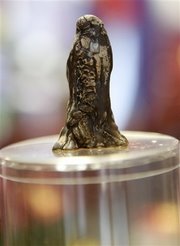 Color me slack: I didn’t get an article together in time for this week’s Skeptics’ Circle. Something turned up this morning, though, so here’s my late entry.
Color me slack: I didn’t get an article together in time for this week’s Skeptics’ Circle. Something turned up this morning, though, so here’s my late entry.Yet another example of pareidolia in the news this week, this time a lump of waste chocolate that triggered someones religious sensibilities.
Actually, it looks like a perched hawk to me. Naturally, religious employees at the chocolate company are idolizing the little lump of hardened goo. At least it looks like the Angianos plan to keep this blob instead of selling it on Ebay like most of the folks who “discover” such things do.FOUNTAIN VALLEY, Calif. - As a chocolatier to the rich and famous, Martucci Angiano has posed with many celebrities — but on Thursday she held in her hand a figure that dazzles her more than any Hollywood star.
Workers at Angiano's gourmet chocolate company, Bodega Chocolates, discovered under a vat a 2-inch-tall column of chocolate drippings that they believe bears a striking resemblance to the Virgin Mary.
-- Article
Tuesday, August 15, 2006
Scenes from Beggar's Rebellion
I don't think it quite lives up to the music Rhys chose. We need to do dramatic death scenes if we're going to go all Hollywood with the soundtrack.
Sunday, August 13, 2006
Victory!
The tournament that she won was a "battle for the pig". Feodor placed a large plastic pig in the field, and the object of the tournament was to make off with it, either by eliminating the competition or by running fifteen feet with it without being intercepted. Fjorleif got hold of the pig and ran with it in the second round, not bothering to engage anyone in actual combat.
The other winners of the initial three rounds were Hawk and Mattheus, and the three of them squared (or, rather, triangled) off for a final free-for-all deathmatch. Both of the guys took two swords, while Fjorleif took my sword and dagger. My good lady wife again avoided combat until Hawk was good enough to kill Mattheus for her. She then played a retreating game until Hawk got impatient and rushed her. She was able to tangle up both his swords during the charge and jab him with the dagger, winning the tournament.
Let that be a lesson to you. Cleverness and treachery can easily outperform skill and talent.
Friday, August 11, 2006
Distillations of Defense
"I have made this of brick and stones, as Augustus said of Rome at the first, but now Rome is built with marble: even so I would wish that some expert and learned person or other would pull down this rude begin work of mine and build it up with marble."
Well, maybe I -- a professional technical writer -- am the expert he sought. I have only a fraction of the fencing experience of Swetnam, but from grinding through his prose I can say that I know a hell of a lot more about writing than he did. In my transcribing effort so far, he has tried and failed something like five times to conclude his "Epistle to the common Reader"; he just can't seem to stop diving off into tangents. His spelling is inconsistent; his grammar is horrendous; and he has absolutely no concept of how to use punctuation. In his defense, I doubt these are unusual failings of Jacobean writers.
But I shall persevere, and hopefully I'll have a concise, coherent manual of Swetnam's fencing style by the time I finish. Excerpts will likely show up here from time-to-time as I progress.
In the meantime, please try not to write like Joseph Swetnam.
Wednesday, August 02, 2006
The Cure for Allergies?
This sounded dubious to me. I figured that exposing someone to allergens in honey would just cause them to have symptoms. Allergy symptoms are just an out-of-control immune reaction; I know of no way to reduce allergic reactions through greater exposure to the allergens.
Nonetheless a quick search the internet found this claim being promoted on a lot of sites. About.com wasn't enthusiastic, but didn’t rule out the possibility either.
My husband and I decided to give the local honey a try. My husband after just a few days noticed a significant difference in the way he felt. After one day of taking a teaspoon of local honey, my allergy symptoms got worse. I even tried a second day, but I continued to feel rotten so I discontiued using the honey.On the other hand ReallyRawHoney.com is a big promoter of the idea:
An Oklahoma allergist told a meeting of 150 beekeepers that raw honey is an effective treatment for 90 per cent of all allergies. Dr. William G. Peterson, an allergist from Ada in the 1950's, said he now has 22,000 patients across the nation who are using raw honey along with more customary medications to relieve allergy symptoms.If only Dr. Peterson’s statements constituted real evidence. Unfortunately, he has only provided a wealth of anecdotes. He has lots of patients using raw honey, but they’re also taking conventional allergy medications. What’s really needed is a randomized, double-blind, placebo-controlled study to determine whether honey actually reduces allergy symptoms. Conveniently, a summary of such a study is available from PubMed.
"It must be raw honey because raw honey contains all the pollen, dust and molds that cause 90 per cent of all allergies," he told a meeting of the Oklahoma Beekeepers Association. "What happens is that the patient builds up an immunity to pollen, dust or mold that is causing his trouble in the first place. The raw honey must "not be strained, not even through a cloth." he added. "I know the customer wants good, clear strained honey, and that's fine, but for health reasons, raw honey is what we need."
Emphasis mine.Department of Pathology, UConn Health Center, Farmington 06030-3105, USA.
BACKGROUND: Allergic rhinoconjunctivitis is a common disorder, affecting >20% of people of all socioeconomic strata. Despite this high prevalence, relatively few sufferers seek professional medical help, presumably because of a widespread reliance on complementary remedies.OBJECTIVE: We investigated the widely held belief among allergy-sufferers that regular ingestion of honey ameliorates the symptoms of allergic rhinoconjunctivitis.
METHODS: The study was conducted at the University of Connecticut Health Center's Lowell P. Weicker General Clinical Research Center. Thirty-six participants who complained of allergic rhinoconjunctivitis were recruited. All recruits were scratch-tested at entry for common aeroallergens. The cohort was randomly assigned to one of three groups, with one receiving locally collected, unpasteurized, unfiltered honey, the second nationally collected, filtered, and pasteurized honey, and the third, corn syrup with synthetic honey flavoring. They were asked to consume one tablespoonful a day of the honey or substitute and to follow their usual standard care for the management of their symptoms. All participants were instructed to maintain a diary tracking 10 subjective allergy symptoms, and noting the days on which their symptoms were severe enough to require their usual antiallergy medication.
RESULTS: Neither honey group experienced relief from their symptoms in excess of that seen in the placebo group.
CONCLUSIONS: This study does not confirm the widely held belief that honey relieves the symptoms of allergic rhinoconjunctivitis.
This was a pretty small study, of course, having only 36 participants, so it’s just a preliminary result. Nonetheless, it’s a preliminary result that seems to refute claims that eating raw honey will reduce allergy symptoms. Furthermore, a number of the websites discussing the subject noted that some people actually had worse symptoms after taking raw honey (which is what I would expect if the honey actually contains something to which the person might react).
Pending further study, I’d say its reasonable to assume that eating lots of raw honey does not reduce allergy symptoms, and eating honey containing your specific allergens might actually cause an attack. Be smart: take your medication and get your honey filtered.
Tuesday, August 01, 2006
Free Plug: Ask the Vet
 One of my high school classmates became a veterinarian, and she now has a radio talk show called Ask the Vet in Knoxville, TN, on WNOX on Sunday mornings starting at 10am Eastern time. The funny thing is that she told me she was tired of the veterinary practice because she'd grown weary of having to explain for the millionth time why pet owners needed to get heartworm medication. So now she answers questions for two hours straight every week, and I know from listening to talk radio that they won't all be really smart questions. Well, maybe if you get the answer to enough people at a time, the question doesn't have to be asked as often.
One of my high school classmates became a veterinarian, and she now has a radio talk show called Ask the Vet in Knoxville, TN, on WNOX on Sunday mornings starting at 10am Eastern time. The funny thing is that she told me she was tired of the veterinary practice because she'd grown weary of having to explain for the millionth time why pet owners needed to get heartworm medication. So now she answers questions for two hours straight every week, and I know from listening to talk radio that they won't all be really smart questions. Well, maybe if you get the answer to enough people at a time, the question doesn't have to be asked as often.Anyway, if you happen to dwell in the Knoxville area or expect to be passing through on a Sunday morning, tune to 100.3 FM to pick up Tracy's show. You can also download previous shows from the archived show page.
Monday, July 31, 2006
Reunification
I had a good time talking with some old friends and shamelessly flirting with ladies that I was too shy to approach way back then. Some silliness you just have to grow out of, I guess.
I was pleasantly surprised to find that a few of my old classmates actually live near me now. I’ve already taken steps to get in touch with them and lure them down the dark path to the SCA. We’ll see how well that works.
Yes, we did take pictures. I have not looked through them to decide which are fit for public display here at the Saga. Time will tell...
Friday, July 28, 2006
Final Video Installment
We're looking at making a lot more videos of various SCA activities, demonstrating practical things like drills and such. Look for new stuff next week.
Wednesday, July 26, 2006
Italian Rapier Parries
In addition, Lady Ysable demonstrate the four basic guard positions of Camillo Agrippa: Prima, Secund, Terza, and Quarta.
Tuesday, July 25, 2006
Fencing Practice Videos
There are a couple more videos, but this is the first time I've tried to embed a Youtube video, and I want to see how it works before I do more. Besides, releasing these slowly gives me blog material for three more days without effort. How can I resist that?
Friday, July 21, 2006
A Good Dance Practice
As I had two brand new students, I tried to keep things simple, which usually means a lot of English Country. I'm finding New Boe Peep to be a good beginner dance, since it's about as simple an English Country Dance as you can get. From there, we proceeded to the somewhat more complicated but ubiquitous Black Nag.
Of course, there's a lot more to Renaissance dancing than English Country (which is, to be honest, outside the SCA period, anyway), so I also taught a few other styles of dance. For 15th-century Italian, we learned the easy and common Petite Riens; for 16th-century Italian, Ballo del Fiore; and from the Inns of Court, the Black Alman. Put together, these are actually a pretty good grounding in SCA dance.
I can only hope to have such a good class next month.
Haunting Evidence Indeed
Tuesday, July 18, 2006
In Search of... Atlantis

Assorted psychics and other supernaturalists have tried to attach themselves to the Atlantis legend, including Ramtha-channeler JZ Knight. They've made wild claims about the achievements of the Atlantean civilization and claimed to have located the city everywhere from the Indian Ocean to shallows of the Carribean Sea. Some have even postulated an entire continent in the middle of the Atlantic Ocean, now sunk beneath the waves. Needless to say, none of their expeditions to these places have turned up anything substantial.
You'd think with all the woo surrounding the story of Atlantis that scientists would want nothing to do with it, but scientists actually studied this story fairly seriously. They've looked for an ancient civilization that fits Plato's description and predates him, preferably located where its tragic tale might have found its way to Greece. Their search resulted the History Channel program called Lost Worlds: Atlantis, which I found myself watching a few nights ago.
Modern scientists have traced "Atlantis" to the Santorini island group which lies north of Crete. Crete itself contains ruins of the Minoan civilization, which was far more advanced than any of its Mediterranean contemporaries, at least in the field of architecture. The Minoans built a multi-story palace at Knossos on the northern coast of Crete that included earthquake-resistant reinforcements and indoor plumbing. They seem to have accomplished many of the "wonders" that Plato describes in his tale of the doomed city. The Minoan civilization fell at about the time of the Thera eruption in 1500-1600 BCE.
Thera is one of the islands in the Santorini group, but it was not the center of the eruption. Thera is just one of several islands that form a ring-shape in the Aegean sea. All of these islands, save one, are part of the rim of a volcano. The central island, Nea Kamini, is the top of the caldera of the volcano. Nea Kamini is a young island that has formed since the Thera eruption. It's quite likely, however, that a similar island existed before the Thera eruption. If "Atlantis" was on this volcanic island, then it truly would have been obliterated in the Thera eruption, since that island would have been the center of the largest volcanic explosion in human history.
Modern archaeologists did not rely on channelling the spirits of dead Atlantean citizens to locate the lost city. They did the hard work of digging out artifacts, dating them, tracing their origins, fact checking against Egyptian records, identifying new sites, digging more, and analyzing their finds to determine that the Minoans had colonized the Santorini islands in the second millenium BCE. They dug through thirty feet and more of volcanic ash and pumice to find the ruins of a Minoan city on Thera. Real science has done more to determine what truth might lie behind Plato's tale of Atlantis than any channeler, dowser, or other psychic has ever done.
If the full truth of the tale of Atlantis is ever going to be found, it's going to be found by scientists, not psychics.






